The Casted Automotive Components Market is estimated to be valued at USD 132.7 billion in 2025 and is projected to reach USD 273.5 billion by 2035, registering a compound annual growth rate (CAGR) of 7.5% over the forecast period.
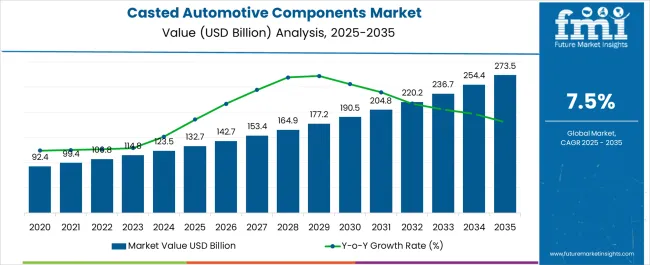
| Metric | Value |
|---|---|
| Casted Automotive Components Market Estimated Value in (2025 E) | USD 132.7 billion |
| Casted Automotive Components Market Forecast Value in (2035 F) | USD 273.5 billion |
| Forecast CAGR (2025 to 2035) | 7.5% |
The Casted Automotive Components market is witnessing strong growth, driven by increasing global demand for lightweight, high-performance components in the automotive industry. Rising vehicle production, particularly in emerging markets, and the emphasis on fuel efficiency and emission reduction are fueling adoption of advanced casted components. The market is further supported by advancements in material science and metallurgical techniques, which enhance durability, corrosion resistance, and mechanical strength of automotive parts.
Integration of aluminum and other lightweight metals has become critical for reducing vehicle weight while maintaining performance standards. Manufacturers are increasingly leveraging advanced production processes, including die casting and sand casting, to achieve high precision and consistent quality. Growing investments in electric vehicle production and engine optimization are also driving demand for high-quality casted components.
Regulatory requirements for safety, efficiency, and environmental compliance are shaping the market landscape As automotive manufacturers continue to prioritize performance, sustainability, and cost efficiency, the casted automotive components market is expected to sustain robust growth, with technological innovation and material advancement driving long-term expansion.
The casted automotive components market is segmented by raw material type, production process, application type, and geographic regions. By raw material type, casted automotive components market is divided into Aluminum, Iron, Zinc, Magnesium, and Others. In terms of production process, casted automotive components market is classified into Die Casting, Squeeze Die-Casting, Pressure Die-Casting, Semi-Solid Die-Casting, Vacuum Die-Casting, Investment Casting, and Others. Based on application type, casted automotive components market is segmented into Engine Parts, Body Assemblies, Transmission Parts, and Others. Regionally, the casted automotive components industry is classified into North America, Latin America, Western Europe, Eastern Europe, Balkan & Baltic Countries, Russia & Belarus, Central Asia, East Asia, South Asia & Pacific, and the Middle East & Africa.
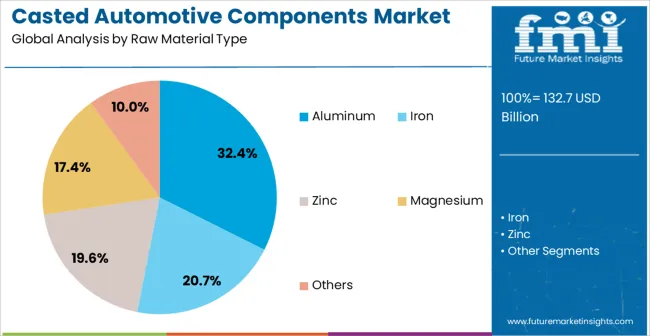
The aluminum segment is projected to hold 32.4% of the market revenue in 2025, establishing it as the leading raw material type. Its market dominance is being driven by the superior strength-to-weight ratio, corrosion resistance, and thermal conductivity that aluminum offers, which are critical for automotive applications such as engine components, chassis, and structural parts. Adoption is further supported by the need to reduce vehicle weight to improve fuel efficiency and lower emissions, which aligns with global regulatory requirements.
Aluminum casting enables precise dimensional control and consistency, allowing manufacturers to produce complex geometries while maintaining structural integrity. Cost-efficiency, recyclability, and compatibility with high-volume production methods strengthen its market position.
As automotive manufacturers increasingly focus on lightweight, high-performance vehicles, the aluminum raw material segment is expected to maintain leadership Continuous innovation in alloy formulations and casting processes ensures that aluminum remains a preferred choice for producing high-quality, durable, and efficient automotive components, reinforcing its share in the market.
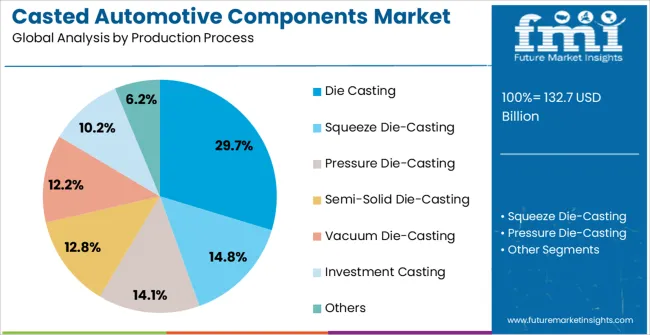
The die casting segment is anticipated to account for 29.7% of the market revenue in 2025, making it the leading production process. Growth in this segment is driven by its ability to deliver high-precision components with excellent surface finish and dimensional consistency. Die casting allows for mass production of complex automotive parts with tight tolerances, which is essential for engine, transmission, and structural applications.
The process is compatible with lightweight metals such as aluminum, further supporting the industry’s demand for fuel-efficient and high-performance vehicles. Reduced machining requirements, shorter production cycles, and enhanced repeatability strengthen its adoption among automotive manufacturers.
Die casting also enables integration of functional features directly into components, lowering assembly costs and improving efficiency As automotive production scales globally and demand for lightweight, durable, and high-quality parts rises, the die casting process is expected to remain the preferred manufacturing method, maintaining its leadership in the production of casted automotive components.
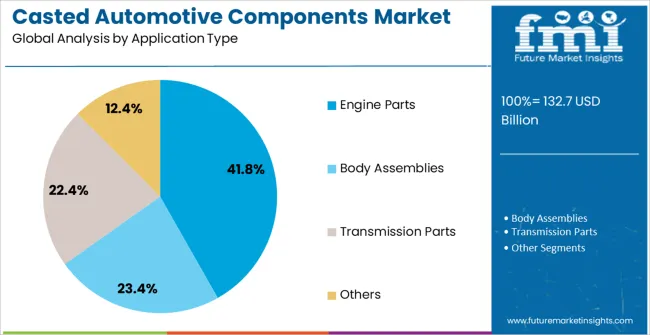
The engine parts segment is projected to hold 41.8% of the market revenue in 2025, establishing it as the leading application area. Growth in this segment is driven by the increasing demand for lightweight and durable components to enhance engine performance, fuel efficiency, and emission control.
Casted components such as cylinder heads, engine blocks, and pistons benefit from precision casting processes and advanced materials like aluminum alloys, which provide superior thermal and mechanical properties. Manufacturers are leveraging these components to reduce engine weight, improve cooling efficiency, and ensure long-term reliability under high stress and temperature conditions.
Regulatory standards for emission reduction and performance optimization are further accelerating adoption of high-quality casted engine parts As automotive OEMs focus on enhancing engine efficiency and transitioning toward hybrid and electric vehicles, demand for casted engine components is expected to sustain its growth, reinforcing the segment’s leading position within the market.
The automobile industry offers a huge market for casted components made using non-ferrous and ferrous metals and its alloys. Casted automotive components offer better surface finish, highly complex designs and weight reduction for major automotive manufacturers worldwide. Different casting processes are used to produce automobile components with required physical and chemical properties.
As the casting method facilitates the formation of simple as well as complex designs and geometry with tighter angle tolerances, it is used to make various automotive components, such as engine blocks, door opening systems, flywheels, sunroofs, tank filling covers, etc. Also, in case of hard metals, such as titanium, for some high-end automobile engine blocks, casting is one of the only practical manufacturing methods as they are not malleable enough to be shaped in the solid state.
Casting also eliminates the need for assembly of multiple pieces as it converts this piece into a single stronger piece with required geometry and lighter weight. Casting of automotive components has a comparatively fast production cycle than other metal shaping methods, such as machining, extrusion, forging, stamping and welding. This makes casting an option for mass production applications.
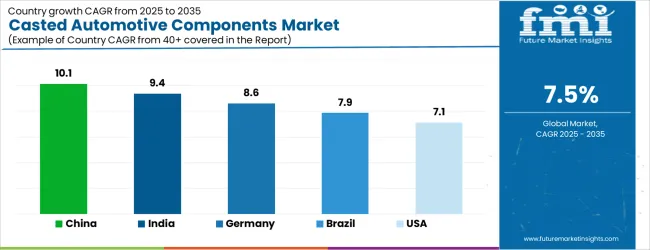
| Country | CAGR |
|---|---|
| China | 10.1% |
| India | 9.4% |
| Germany | 8.6% |
| Brazil | 7.9% |
| USA | 7.1% |
| UK | 6.4% |
| Japan | 5.6% |
The Casted Automotive Components Market is expected to register a CAGR of 7.5% during the forecast period, exhibiting varied country level momentum. China leads with the highest CAGR of 10.1%, followed by India at 9.4%. Developed markets such as Germany, France, and the UK continue to expand steadily, while the USA is likely to grow at consistent rates. Japan posts the lowest CAGR at 5.6%, yet still underscores a broadly positive trajectory for the global Casted Automotive Components Market. In 2024, Germany held a dominant revenue in the Western Europe market and is expected to grow with a CAGR of 8.6%. The USA Casted Automotive Components Market is estimated to be valued at USD 48.2 billion in 2025 and is anticipated to reach a valuation of USD 48.2 billion by 2035. Sales are projected to rise at a CAGR of 0.0% over the forecast period between 2025 and 2035. While Japan and South Korea markets are estimated to be valued at USD 6.4 billion and USD 3.6 billion respectively in 2025.
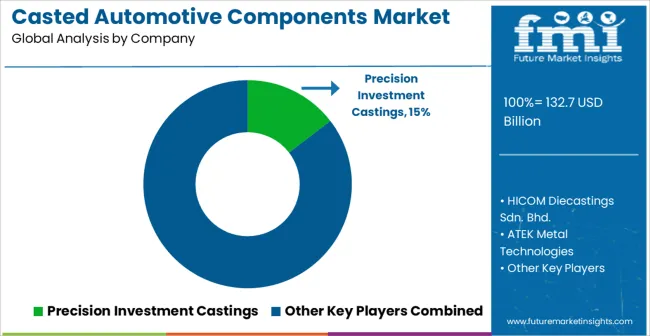
| Item | Value |
|---|---|
| Quantitative Units | USD 132.7 Billion |
| Raw Material Type | Aluminum, Iron, Zinc, Magnesium, and Others |
| Production Process | Die Casting, Squeeze Die-Casting, Pressure Die-Casting, Semi-Solid Die-Casting, Vacuum Die-Casting, Investment Casting, and Others |
| Application Type | Engine Parts, Body Assemblies, Transmission Parts, and Others |
| Regions Covered | North America, Europe, Asia-Pacific, Latin America, Middle East & Africa |
| Country Covered | United States, Canada, Germany, France, United Kingdom, China, Japan, India, Brazil, South Africa |
| Key Companies Profiled | Precision Investment Castings, HICOM Diecastings Sdn. Bhd., ATEK Metal Technologies, Gibbs Die Casting, Spark Minda, GF Casting Solutions AG, Diecasting Solutions, Endurance Technologies, Rockman Industries, Lestercast Limited, Impro Precision Industries Limited, Barron Industries, and Hitachi Metals |
The global casted automotive components market is estimated to be valued at USD 132.7 billion in 2025.
The market size for the casted automotive components market is projected to reach USD 273.5 billion by 2035.
The casted automotive components market is expected to grow at a 7.5% CAGR between 2025 and 2035.
The key product types in casted automotive components market are aluminum, iron, zinc, magnesium and others.
In terms of production process, die casting segment to command 29.7% share in the casted automotive components market in 2025.






Our Research Products

The "Full Research Suite" delivers actionable market intel, deep dives on markets or technologies, so clients act faster, cut risk, and unlock growth.

The Leaderboard benchmarks and ranks top vendors, classifying them as Established Leaders, Leading Challengers, or Disruptors & Challengers.

Locates where complements amplify value and substitutes erode it, forecasting net impact by horizon

We deliver granular, decision-grade intel: market sizing, 5-year forecasts, pricing, adoption, usage, revenue, and operational KPIs—plus competitor tracking, regulation, and value chains—across 60 countries broadly.

Spot the shifts before they hit your P&L. We track inflection points, adoption curves, pricing moves, and ecosystem plays to show where demand is heading, why it is changing, and what to do next across high-growth markets and disruptive tech

Real-time reads of user behavior. We track shifting priorities, perceptions of today’s and next-gen services, and provider experience, then pace how fast tech moves from trial to adoption, blending buyer, consumer, and channel inputs with social signals (#WhySwitch, #UX).

Partner with our analyst team to build a custom report designed around your business priorities. From analysing market trends to assessing competitors or crafting bespoke datasets, we tailor insights to your needs.
Supplier Intelligence
Discovery & Profiling
Capacity & Footprint
Performance & Risk
Compliance & Governance
Commercial Readiness
Who Supplies Whom
Scorecards & Shortlists
Playbooks & Docs
Category Intelligence
Definition & Scope
Demand & Use Cases
Cost Drivers
Market Structure
Supply Chain Map
Trade & Policy
Operating Norms
Deliverables
Buyer Intelligence
Account Basics
Spend & Scope
Procurement Model
Vendor Requirements
Terms & Policies
Entry Strategy
Pain Points & Triggers
Outputs
Pricing Analysis
Benchmarks
Trends
Should-Cost
Indexation
Landed Cost
Commercial Terms
Deliverables
Brand Analysis
Positioning & Value Prop
Share & Presence
Customer Evidence
Go-to-Market
Digital & Reputation
Compliance & Trust
KPIs & Gaps
Outputs
Full Research Suite comprises of:
Market outlook & trends analysis
Interviews & case studies
Strategic recommendations
Vendor profiles & capabilities analysis
5-year forecasts
8 regions and 60+ country-level data splits
Market segment data splits
12 months of continuous data updates
DELIVERED AS:
PDF EXCEL ONLINE
Automotive Exhaust Components Aftermarket Market
Automotive Brake System & Components Market Growth - Trends & Forecast 2025 to 2035
Automotive Interior Plastic Components Market Size and Share Forecast Outlook 2025 to 2035
Automotive Electric Drivetrain Components Market Size and Share Forecast Outlook 2025 to 2035
Automotive Direct Liquid Cooling IGBT Module Market Size and Share Forecast Outlook 2025 to 2035
Automotive Hoses and Assemblies Market Size and Share Forecast Outlook 2025 to 2035
Automotive Network Testing Market Size and Share Forecast Outlook 2025 to 2035
Automotive Performance Part Market Size and Share Forecast Outlook 2025 to 2035
Automotive Carbon Ceramic Brake Market Size and Share Forecast Outlook 2025 to 2035
Automotive Camshaft Market Size and Share Forecast Outlook 2025 to 2035
Automotive Stamping Industry Analysis in India Size and Share Forecast Outlook 2025 to 2035
Automotive Cylinder Liner Market Size and Share Forecast Outlook 2025 to 2035
Automotive Microcontroller Market Size and Share Forecast Outlook 2025 to 2035
Automotive Roof Rails Market Size and Share Forecast Outlook 2025 to 2035
Automotive Active Safety System Market Size and Share Forecast Outlook 2025 to 2035
Automotive Diagnostic Scan Tool Market Size and Share Forecast Outlook 2025 to 2035
Automotive Test Equipment Market Size and Share Forecast Outlook 2025 to 2035
Automotive Dynamic Map Data Market Size and Share Forecast Outlook 2025 to 2035
Automotive Green Tires Market Size and Share Forecast Outlook 2025 to 2035
Automotive E-Tailing Market Size and Share Forecast Outlook 2025 to 2035

Thank you!
You will receive an email from our Business Development Manager. Please be sure to check your SPAM/JUNK folder too.
Chat With
MaRIA